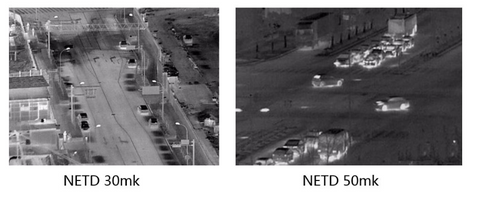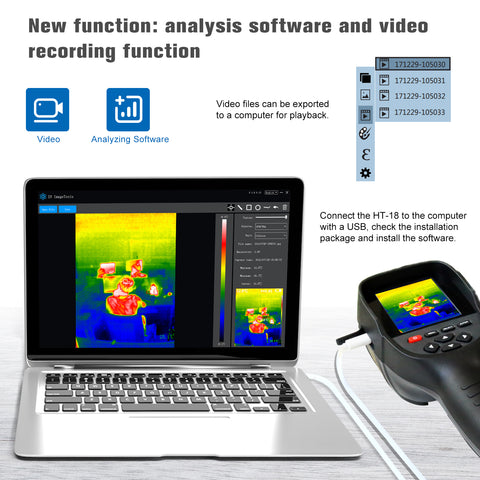01.Thermal imaging principle
All objects in nature, as long as its temperature is higher than the absolute temperature ( − 273 ° C ) there is irregular movement of molecules and atoms, the surface will continue to radiate infrared light. Thermal imaging mainly collects infrared light in the thermal infrared band ( 8μm-14μm ) to detect the thermal radiation emitted by the object. After detecting thermal radiation, it is converted into gray value, and the difference of gray value of each object is used to image, so as to find and identify the target.
As shown in the following figure, the left part of the car is a visible light photo, and the right part is a thermal imaging photo. It can be seen that the thermal imaging image presents the car with different surface temperature of each part through different grayscale differences.

02.Introduction of Thermal Imaging Camera
Similar to the principle of ordinary camera, thermal radiation is equivalent to visible light, first through the lens to the detector, in the processing of images, and finally output stream, forming a video image for human observation.
In the whole imaging process, thermal imaging lens and infrared detector are important components of thermal imaging camera.
Thermal imaging lens :
The thermal imaging lens uses a germanium lens. High purity germanium single crystal has a high refractive index, which can block visible light and ultraviolet light outside and only let infrared light pass.

Infrared detector :
Thermal imaging detectors are divided into cooled detectors and uncooled detectors.
Refrigeration equipment with high sensitivity, fast response, clear image, but the need for low-temperature refrigeration, resulting in larger and expensive. Generally used in the military industry.
Sensitivity of non-refrigerated equipment is slightly lower, but basically meet civil requirements, and no need for low-temperature refrigeration, the price is only one-tenth to one-tenth of refrigeration equipment. At present, the mainstream uncooled detectors generally use vanadium oxide or polycrystalline silicon.
03.Key Indicators of Thermal Imaging Camera
Field of view :
With the lens as the vertex, the angle between the two edges of the maximum range of the lens through which the object image of the measured target can be formed is called the field angle.

The relationship between field angle and focal length : Generally, the larger the field angle, the shorter the focal length.
Resolution :
The resolution of the detector is an important parameter to measure the quality of the detector, which indicates how many unit detectors are on the focal plane of the detector.
The current mainstream resolution is 160 × 120, 384 × 288, 640 × 512, 1024 × 768 and so on. With other conditions unchanged, the higher the resolution, the clearer the imaging.
Spatial resolution :
Spatial resolution ( IFOV ) refers to the minimum limit of the spatial geometric length of the object that can be recognized in the image, that is, the resolution of the fine structure. IFOV is generally derived from the ratio of pixel size ( d ) to focal length ( f ), that is, IFOV = d / f.For example, the pixel size of the focal plane of the thermal imaging device is 17μm, with a 100mm focal length lens, then its FOV = 17 / 100 = 0.17 mrad. When the unit distance is the same, the smaller the IFOV, the smaller the area that a single pixel can detect, and the unit measurement area is composed of more pixels. The more details the image presents, the clearer the imaging is.
NETD ( noise equivalent temperature difference ) :
NETD, also known as thermal sensitivity, is the ability of a device to accurately distinguish the minimum temperature difference in target radiation from the background. For example : NETD ≤ 30mk ( @ 25 ° C, F # = 1.0 ), which means that the surface temperature of the measured object is assumed to be 25 ° C, and the minimum temperature change detected by the infrared thermal imager is 0.03 ° C. So, to some extent, the smaller the NETD value, the better the image quality. Its importance is equivalent to the signal-to-noise ratio of visible light.

MRTD ( Minimum Resolvable Temperature Difference ) :
The objective measurement method of MRTD is based on the subjective measurement method. Subjective MRTD measurement is based on the definition of MRTD. Four bar patterns with different spatial frequencies and aspect ratios of 7 : 1 are placed in a uniform background. The temperature difference between the target and the background gradually increases from zero. When the observer can just distinguish the four-bar pattern at a given spatial frequency, the temperature difference between the target and the background is called the minimum resolvable temperature difference MRTD of the spatial resolution.



